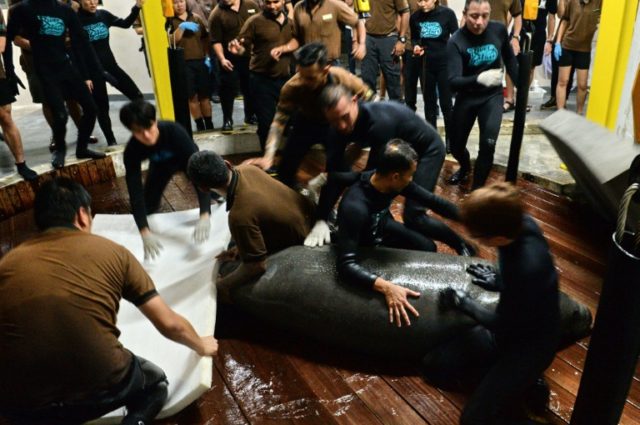Singapore (AFP) – Two manatees born and bred at the Singapore Zoo left the city-state early Monday for Guadeloupe as part of the world’s first repopulation programme for the mammal, which became extinct on the French Caribbean island.
Males Kai, seven, and Junior, six, left Singapore at 4:50 am (2050 GMT Sunday) for the 34-hour journey on a chartered Singapore Airlines cargo flight, the zoo operator said.
After a farewell ceremony on Sunday attended by representatives from the French embassy, the manatees — weighing hundreds of kilos — were coaxed onto canvases and placed in custom-built open-top crates lined with thick sponge, an operation involving dozens of zoo staff.
They will be periodically sprayed with water during the journey. Two veterinarians from Guadeloupe’s national park and an aquarist from Singapore’s zoo are travelling with them.
Kai and Junior, who were born in captivity, are the first of 15 of their kind to arrive in the Grand Cul-de-Sac Marin, a 15,000 hectare (37,000 acre) protected bay in Guadeloupe, a French overseas territory in the southern Caribbean.
They will be joined by 13 others of different genders from zoos around the world.
Any offspring from the group will be released into the wild as part of the repopulation programme.
“We are happy to have the opportunity to contribute towards repopulating part of the manatees’ historic range in the Caribbean, where they have not been sighted in over a century,” said Mike Barclay, chief executive of Singapore Zoo operator Mandai Park Holdings.
“Projects like this allow us to do our bit to protect and conserve the world’s biodiversity,” he said at the farewell ceremony Sunday.
Discussion of the repopulation programme started in 2007 and included educating the Guadeloupe public about the animals also known as sea cows, US-based project consultant Ray L. Ball told AFP Sunday.
“You can’t reintroduce an animal species to a country if the people don’t want it,” he said.
Known locally in Guadeloupe as “maman d’lo” or mother of the sea, West Indian manatees were an important part of the territory’s ecology until they were hunted to extinction in the early 20th century.
The species is listed as “vulnerable” on the International Union for Conservation of Nature’s Red List of Threatened Species, with the West Indian variety becoming extinct in the Caribbean due to overhunting.
A gentle creature which can grow to up to 4.5 metres (15 feet) in length, the manatee’s natural habitats are warm coastal waters, mangrove swamps and estuaries where they graze on plants.

COMMENTS
Please let us know if you're having issues with commenting.